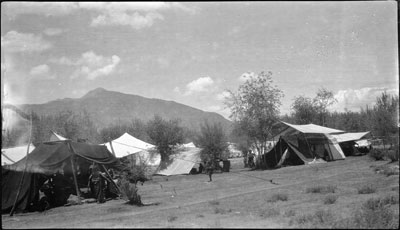
1998.285.515 (Film negative)


1998.285.515 (Film negative)

Lt Col R. S. Kennedy? Willoughby Patrick Rosemeyer?
Sir Charles Bell
May-September 1921 or 1922
Lhasa >
1998.285.515
137 x 80 mm
Negative film nitrate
Donated 1983
St. Antony's College, Oxford
Sir Charles Bell's Mission to Lhasa 1920-21
Sir Charles Bell; Royal Central Asiatic Society
Not Bell? Rosemeyer? Kennedy/
P.268
BL.P.268
British Library, Oriental and India Office Collections
'The People of Tibet', Sir Charles Bell, Oxford: Clarendon Press, 1928 [view list of illustrations]
Manual Catalogues - Bell's List of Illustrations entry: "[No. of chapter] XXVII. [Subject of Chapter] Amusements. [Subject of illustration] P. 268 (bcdu) Ditto [ref: H.149/1998.285.172: A lingka near Lhasa with tents of picnicking parties]"
Contemporary Publication - Published in 'The People of Tibet', Bell, C. A., Oxford: Clarendon Press, 1928, facing p.265:"A ling-ka near Lhasa with tents of picnicking parties. The trees are willow and poplar." [MS 10/9/2004]
Other Information - Cultural Background: Bell's Diary for 5th May 1921 reports the following information as told to Bell by Kusho Palhese:"The people of Lhasa repair to the ling-kas for picnics mainly between the 3rd and 7th months (say) from May to August inclusive. Riding today through some of the ling-kas I came across fourteen or fifteen of these picnic parties. The Chinese and the Ladakhis usually had a white tent roof, gaily ornamented with the usual blue desings, over their parties, while the Tibetans sat under trees with only a cloth some five feet high stretched along one side to keep off the wind." [Vol. X., p.51]
Other Information - Cultural Background: On 25th May 1921 Bell discussed popular forms of Tibetan entertainment with Kusho Palhese and this prompted the following Diary entry in relation to picnic parties:"Apart from these games [ horse racing, archery, putting the weight, long-jumping ] picnicking is a very favourite way of spending the day in summer. Between May and September the lingkas are full of picnic parties. Whether government owned or private owned any may come and bring their lunch and tea and spend the day there. Those who are more particular pitch a tent or the roof of a tent, white with blue designs after the Tibetan fashion. Others just sit down under the poplars or willows, and hang a cloth on one side to keep off the breeze. Sho and Ba (Chinese dominoes) will be played, singing and perhaps dancing especially towards evening, and the stories of older days will be recounted by those who know them. Beer and tea there will be in plenty, and food mostly after the Chinese style." [Diary Vol. X., p.82]
Other Information - Photographer: Bell did not use P-sized or 'Postcard' sized negatives of the kind with which this image is made for his images of Lhasa in 1920-21. However, Lt Col Robert Kennedy, who was with Bell in 1920-21, did so, as did W. P. Rosemeyer, who visited Lhasa many times from 1922 onwards as a telegraph officer involved with establishing the telegraph line to Lhasa. This is a copy of a print, not an original image, and the print may well have been acquired by Bell from one of these sources [MS 25/02/2006]
For Citation use:
The Tibet Album.
"Picnickers in a Lhasa park"
05 Dec. 2006. The Pitt Rivers Museum.
<http://tibet.prm.ox.ac.uk/photo_1998.285.515.html>.
For more information about photographic usage or to order prints, please visit the The Pitt Rivers Museum.
© The Pitt Rivers Museum